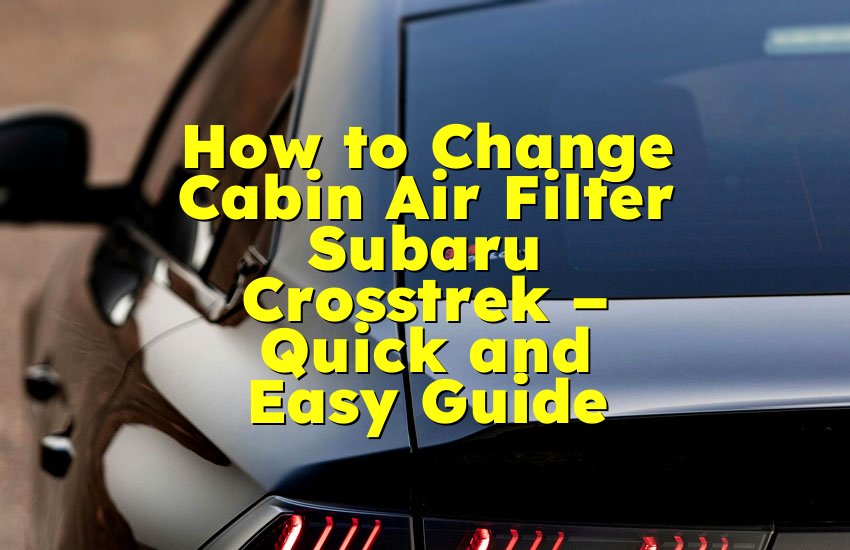As an Amazon Associate, I earn from qualifying purchases at no extra cost to you.
How to Change Cabin Air Filter Ford F150 (Expert Guide)
Ever noticed your Ford F-150's air feels stuffy or smells weird inside the cabin? That's usually a sign your cabin air filter is begging for attention. Many drivers skip it, but swapping it out is easier than you think. With a little patience and the right filter, you can have fresh, clean air in minutes. Let's walk through a simple, practical way to change it without any hassle.
Key Takeaways: First, locate your cabin air filter behind the glove compartment or under the dash. Open the glove box carefully and remove any stops or clips blocking access. Slide out the old filter and inspect it for dust, dirt, or leaves. Make sure to note the airflow direction marked on the filter. Take your new filter, insert it correctly, ensuring it sits flush and snug. Close the glove box and test your HVAC system to confirm airflow feels strong and clean.
Finding Your Cabin Air Filter Location
Before you grab the screwdriver, it's essential to know exactly where the cabin air filter lives in your Ford F-150. Most models have it tucked behind the glove box, but some newer versions might hide it under the dash or even behind a small access panel. Knowing the precise location saves a lot of frustration and time.
Start by opening your glove box and looking for side stops or clips that prevent it from swinging fully down. These stops are easy to remove—sometimes you just need to gently squeeze the sides and pull them out. If you have trouble spotting the filter housing, a flashlight can help. Some F-150s have a rectangular plastic cover behind the glove compartment that snaps off with a little pressure. Once you remove this cover, you can clearly see the filter sitting neatly inside.
Understanding the layout before touching anything keeps you from accidentally breaking clips or scratching panels. Also, take a moment to look at the airflow arrows on the old filter. These arrows show which way the air flows through your HVAC system, which is crucial when inserting the new filter. Skipping this small check can reduce airflow and efficiency, making your new filter less effective.
- Most filters are behind the glove compartment
- Use flashlight for better visibility
- Remove stops or clips carefully
- Look for airflow direction on the old filter
Removing the Old Cabin Air Filter
Pulling out the old filter might seem tricky at first, but it's really straightforward once you know the steps. With your glove box open and stops removed, gently slide the filter out of its housing. You might notice it's dirty, filled with dust, leaves, or even tiny debris from the road. This is exactly why replacing it regularly matters.
Be sure to take note of how the filter sits in the housing. Most have an airflow arrow pointing downwards or toward the blower motor. If your filter is clogged, it might be harder to slide out; in that case, wiggle it gently to avoid bending the filter or damaging the housing. While the old filter is out, you can also quickly vacuum inside the filter compartment to remove any leftover dust. This step ensures your new filter won't get dirty immediately.
Once removed, dispose of the old filter responsibly. You might want to keep a small plastic bag nearby to drop the dirty filter in without making a mess. This keeps your workspace clean and prevents dirt from falling into the HVAC system.
- Slide out filter gently
- Note airflow direction
- Clean housing before installing new filter
- Dispose of old filter carefully
Installing the New Cabin Air Filter
Now comes the fun part—putting in the fresh filter. Take your new filter and check the airflow arrows. This small detail ensures your HVAC system pulls and pushes air efficiently. With the arrow pointing in the correct direction, slide the filter into the housing slowly. Make sure it sits fully flush on all sides; forcing it too hard can bend the filter or damage the housing.
Sometimes the new filter might feel slightly snug compared to the old one. That's normal—it's supposed to form a tight seal to trap dust and pollen. Take your time sliding it in evenly. Once the filter is seated, double-check that it doesn't move around inside the housing. Then, snap the plastic cover back on if your model has one and reattach the glove box stops.
Finally, close the glove box and turn on your truck's A/C or heater. Feel the airflow; it should be stronger and cleaner than before. If you notice any blockage or strange noise, reopen the compartment and ensure the filter is properly aligned. Proper installation not only improves air quality but also keeps your HVAC system running efficiently.
- Check airflow arrows before installation
- Slide new filter slowly and evenly
- Ensure filter fits snugly
- Reattach glove box and test airflow
Checking Your HVAC System After Installation
After swapping your cabin air filter, it's important to see how your HVAC system responds. Turn on the fan to different speeds and listen carefully. You should notice airflow feels stronger and more consistent. Also, smell the air—there shouldn't be any musty or dusty odor lingering. If it still smells bad, consider running the air with the AC on for a few minutes to clear any residual dust.
Keep an eye on the vents as well. Properly installed filters ensure air comes out evenly from all vents. If airflow seems weak from certain vents, double-check that the filter is seated correctly and the housing cover is fully in place. Occasionally, small leaves or debris may fall into the system during installation; a quick visual check can prevent future issues.
Maintaining your HVAC after a filter change extends its life. Clean vents and periodically inspect your filter to make sure it stays effective. Even though replacing it is easy, skipping this small step could reduce comfort and performance in your truck.
- Turn on HVAC to test airflow
- Smell air for freshness
- Check vents for even airflow
- Inspect filter seating and housing cover
How Often to Replace Your Cabin Air Filter
Replacing your cabin air filter isn't a one-size-fits-all schedule. If you drive in dusty areas or heavy traffic, you might need to change it every 10,000 miles. On smoother highways or cleaner areas, 15,000–20,000 miles is usually fine. Seasonal changes can also impact how quickly filters get dirty, especially if pollen or leaves are high in your area.
Keeping track of your filter replacement schedule prevents HVAC strain and keeps cabin air fresh. You can jot it down in a maintenance log or set a phone reminder. If you notice reduced airflow, strange smells, or increased dust in your truck, it's a sign to check the filter earlier than expected. Being proactive helps avoid more expensive HVAC repairs later.
Replacing the filter regularly also benefits your health. Cabin air filters trap pollen, dust, and allergens, which is especially important if someone in the vehicle has allergies or respiratory issues. Clean air inside the cabin creates a more comfortable driving experience for everyone.
- Replace every 10,000–20,000 miles depending on conditions
- Check filter during seasonal changes
- Track replacements in a log
- Improves air quality and HVAC longevity
Quick Tips and Maintenance Tricks
Keeping your cabin air filter working well is simple with a few extra habits. Avoid eating in the truck to reduce crumbs, clean your interior vents occasionally, and keep windows closed in dusty areas. These small habits prevent the filter from clogging too quickly.
Also, consider keeping a spare filter in your truck. This allows you to replace it immediately if you notice a sudden drop in airflow or a musty smell. When installing a new filter, handle it by the edges to avoid pushing dust into the pleats. Lastly, inspect the surrounding area during each replacement to catch leaves, insects, or debris before they enter your HVAC system.
- Avoid eating in the truck
- Clean vents regularly
- Keep spare filter on hand
- Handle new filter by edges
Final Thoughts
Changing your cabin air filter in a Ford F-150 is easier than most drivers think. A few minutes, a new filter, and some simple steps can drastically improve air quality, airflow, and comfort in your truck. Regular maintenance protects your HVAC system, keeps dust and allergens out, and saves you from costly repairs. Once you try it, you'll see why it's one of the easiest and most rewarding DIY tasks for any Ford F-150 owner.
| Task | Recommended Action | Tips & Notes |
|---|---|---|
| Locate filter | Behind glove compartment or under dash | Use flashlight for visibility |
| Open glove box | Remove stops or clips | Be gentle to avoid damage |
| Remove old filter | Slide out carefully | Check airflow direction |
| Inspect housing | Clean out dust/debris | Use vacuum if necessary |
| Install new filter | Insert correctly with arrow | Ensure snug fit |
| Replace cover | Snap back in place | Make sure it clicks |
| Test HVAC | Turn on fan and check airflow | Listen for smooth operation |
| Track replacement | Log miles or date | Replace 10k–15k miles |
Frequently Asked Questions (FAQs)
Is it difficult to change the cabin air filter on a Ford F-150?
Not at all. With most models, the filter is behind the glove compartment, so it's easy to access. You don't need any special tools beyond a screwdriver for the glove box stops. Carefully sliding the old filter out and inserting a new one takes only a few minutes. If you follow the airflow direction and ensure the filter sits snugly, you'll have fresh air flowing in no time. Many people find it easier than changing an oil filter.
Can I drive without a cabin air filter?
Technically, yes, but it's not recommended. Without a filter, dust, pollen, and debris can enter your HVAC system, reducing airflow and potentially damaging components. It also lets allergens and dust circulate inside your cabin, which isn't healthy for anyone in the truck. A filter protects both your HVAC system and your health, so it's best to replace it regularly.
Do I need a special filter for my F-150 model year?
Yes, filters vary depending on your truck's year and configuration. Always check your owner's manual or the packaging for compatibility. Using the wrong size can prevent proper seating, reduce airflow, and allow dust into the system. OEM filters are usually recommended, but high-quality aftermarket options also work well if they fit correctly.
Is it necessary to check the airflow direction?
Absolutely. Filters have arrows showing airflow direction. Installing it backwards reduces efficiency and airflow, which can make your HVAC system work harder. Always match the arrow with the airflow in your truck's system. Double-checking this small detail ensures optimal air quality and performance.
Can a dirty cabin air filter cause odors?
Yes. Over time, dust, mold, and debris accumulate in the filter. This buildup can cause a musty or dusty smell when you turn on the AC or heater. Replacing the filter removes trapped contaminants and refreshes the air in your cabin. Running the system briefly after installation can help clear any lingering odors.
Do I need to clean the filter housing each time?
It's a good practice. While removing the old filter, vacuum any dust or debris from the compartment. A clean housing prevents premature clogging of your new filter and keeps the airflow smooth. Even a small amount of dust left behind can reduce the efficiency of your new filter.
Is it worth keeping a spare filter in my truck?
Yes, keeping a spare filter is convenient, especially if you drive in dusty or high-pollen areas. It allows you to swap the filter immediately if airflow drops or a smell develops. Having a backup prevents long periods of poor air quality and helps maintain your HVAC system's performance.
Can a cabin air filter affect heating and cooling performance?
Definitely. A clogged or dirty filter restricts airflow, making your AC or heater work harder. You might notice weak airflow, longer cooling times, or uneven heating. Replacing the filter restores proper airflow, improves efficiency, and can even save a small amount on fuel by reducing HVAC strain.











